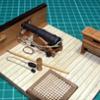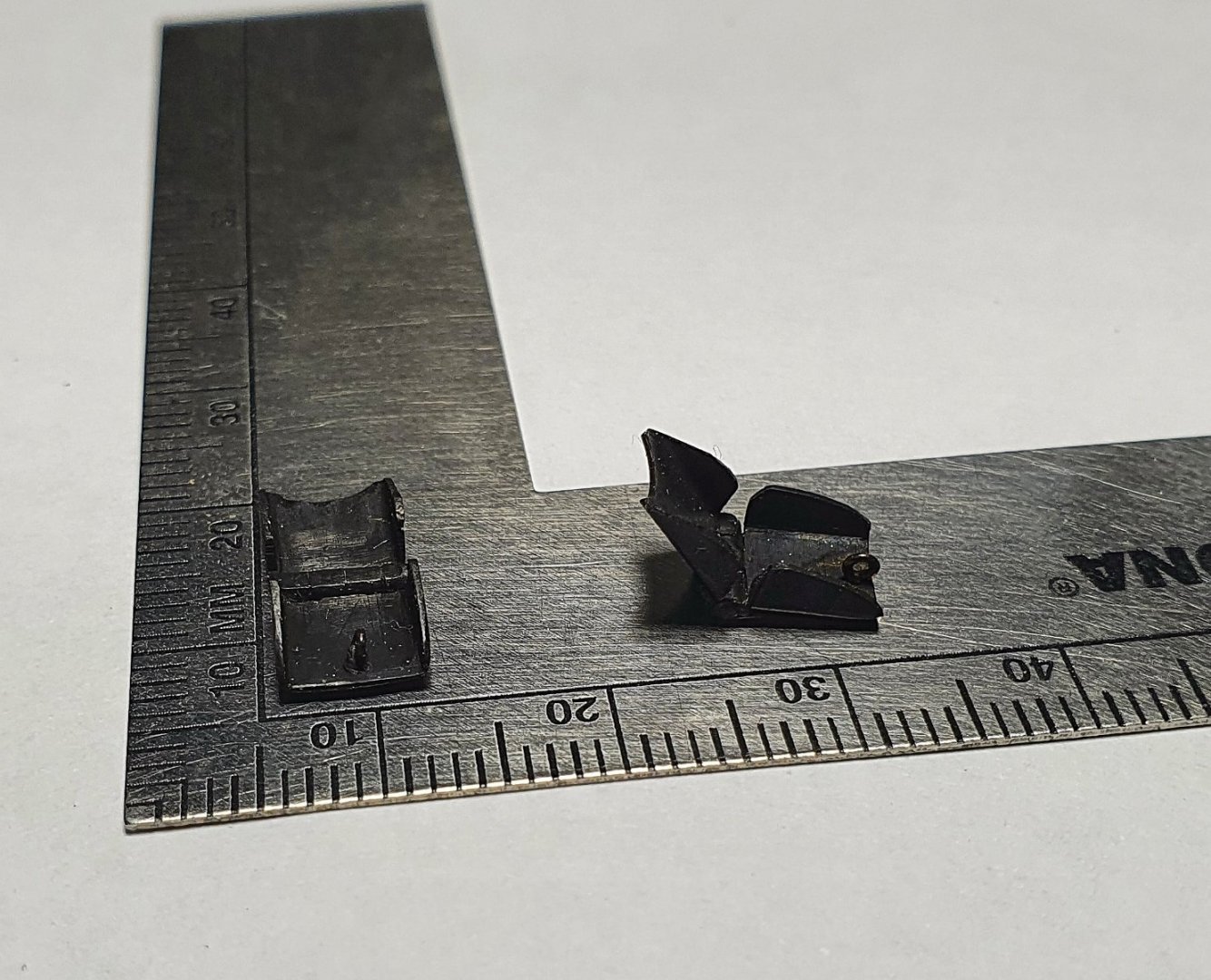-
Posts
5,918 -
Joined
-
Last visited
Content Type
Profiles
Forums
Gallery
Events
Everything posted by BANYAN
-
A great way to display the model Rob, it is unique, has historical and practical relevance. cheers Pat
- 3,560 replies
-
- clipper
- hull model
-
(and 2 more)
Tagged with:
-
Couldn't agree more Clipper, well commented. cheers Pat
- 3,560 replies
-
- clipper
- hull model
-
(and 2 more)
Tagged with:
-
Terry, I have found, that in this period, there were several variations of what were called "Trick" anchor release mechanisms in this period. If you would like a copy of what I have assembled please let me know and I will PM the info. cheers Pat
- 5 replies
-
- anchor cleat
- brigantine
-
(and 3 more)
Tagged with:
-
I have also just stumbled on this incredible work - take a bow John, simply impressive detail at this scale. The pocket watch model just blew my socks off. I won't complain about working at 1:72 again . cheers Pat
-
Great collection of photos Keith. I find they help add a sense of realism to the model making process - I often find my reminiscing on what those times would have been like (please find me a way-back machine ). cheers Pat
-

Brass Blackening Building Time Survey
BANYAN replied to Dave_E's topic in Metal Work, Soldering and Metal Fittings
Joe, from my experience and what you describe, I think you need to dilute the blackening agent. A 100% solution often results in the process reacting too fast. Rather than etching the surface, it builds a layer of black sooty like residue which easily washes off. After proper cleaning /preparation, try using a 50/50 solution diluted with demineralised water/blackening agent. For small part I even go as low as 30/70 (70% water). The process takes slightly longer, but usually when you take the parts out and rinse, then buff them, you end up with a dark metallic grey finish. For a darker finish, leave it in a bit longer, or put it back in for a second dip. Hope this helps. Cheers Pat -
but Keith .... imagine what could be hidden behind the smoke from a full broadside. First salvo fired, let the iron balls fly... now there's an idea, add cannon balls on the fly cheers Pat [edit] Sorry Glen, couldn't help myself - they'll have to lock me up next.
- 177 replies
-
- Independence
- bottle
-
(and 1 more)
Tagged with:
-
The planking (deck and side) looks good Marty. I would definitely seal the deck and sides with a coat of something. I used Testor's 'Dullcote' which is a flat varnish. I only used a single coating at this stage as you may need to scrape small sections back where you need to glue things to the deck. I am glad I sealed mine as it really protects the deck from the grime etc while working it. Dullcote allows touch up that just 'meld' in without any noticeable edges etc. Some people prefer waxes or oils, but I find the Dullcote easier to work with and gives a fairly realistic finish (not glossy). I also found you can put heavier duty final coats of finish over it without difficulty if you want a different finish. Choice of finish is yours though; good luck. I am not promoting Dullcote by any stretch of the imagination; just a happy user. cheers Pat
-
I think I recall someone having that at small scales at Shapeways. I'll let you know if I find anything. [edit} - Found these - at wrong scale but as the artwork is done may print of in your scale? https://www.shapeways.com/marketplace/miniatures/ships?type=product&q=refueling+at+sea cheers Pat
-
Looks great Rob, that's a novel and unique way to display her. cheers Pat
- 3,560 replies
-
- clipper
- hull model
-
(and 2 more)
Tagged with:
-
Lots of nice detail which is really bringing her to life; nicely done. Are you replacing the refuelling equipment also (bellmouth receiver, hose etc)? cheers Pat
-
Teaser! Looking forward to seeing it. A clever idea you have come up with. cheers Pat
- 3,560 replies
-
- clipper
- hull model
-
(and 2 more)
Tagged with:
-
Hi John, the method you described in our crossed posts is similar to what I think was used in Victoria. In my case, there were a couple of access hatches used and portable cranes used for ash removal. The use of the chutes and wheelbarrow on the upper deck was deduced from info I found online (I'll send a PM). The use of portable cranes for ash removal was stated in the ship's contract. cheers Pat
-

Brass Blackening Building Time Survey
BANYAN replied to Dave_E's topic in Metal Work, Soldering and Metal Fittings
Dave, unfortunately, I do my brass work piece-meal as required and don't time it. In overall 'terms' though I believe it would be no more than one or two (at the most) days (8 hour days) worth for my Endeavour (kit). The process I use is relatively quick so it that part of my metal-smithing is not really a concern for me. My current build (HMCSS Victoria) is a scratch build with a fair element of metal work but I will have spent less than half a day total in the blackening process so far. Honestly, most of my time in metal-smithing is put into developing the right jig/holding and soldering arrangements. The process for actually soldering, cleaning and blackening are pretty quick once the hard-part is done and most only take a few minutes once the part is made. Mark, I must use a different way, as even if only (say) a single barrel is worked, I rarely get an even coverage/blackening etch on the first pass , yet I can put up to 25 eyes into solution at once and have the entire process (black, rinse, buff) done within two minutes. Overall, I find that rarely do larger pieces get a full coverage and/or an acceptable finish on the first pass - must be my technique? The result is that I spend more time doing larger than smaller pieces - the time in the solution is not what I am talking about (that is the same for anything I do). cheers Pat -
That is exactly how the ash was dispersed on the Victoria (1855) also John, except that rather than a gun port, an ash chute was used. Once hoisted by bucket/box or whatever, it was transferred to a 'special purpose' wheelbarrow. The ash was then emptied through an opening at the appropriate height for the wheelbarrow on the leeward side. The chutes had fold down/up parts to allow the ash to be 'pushed' further outboard from the ship's side. The type I used are shown below (at 1:72) but have yet to be fitted - I am thinking of fixing the size of the eyebolts/eyes also. Your model is coming along beautifully. cheers Pat
-
Coming along beautifully Rob; just the stimulus (to watch your work) to get me going again cheers Pat
- 3,560 replies
-
- clipper
- hull model
-
(and 2 more)
Tagged with:
-
A stunning result, and a very unique display stand Glen. cheers Pay
- 177 replies
-
- Independence
- bottle
-
(and 1 more)
Tagged with:
-

Brass Blackening Building Time Survey
BANYAN replied to Dave_E's topic in Metal Work, Soldering and Metal Fittings
Dave, the answer is: depends on the size of the piece being blackened and on the quality of the brass (and whether it has been cleaned/prepared properly) and the strength of the solution being used. If we assume that any part is properly prepared, small bits takes only a minute or so in a solution (even less if full strength solution is needed), a cannon barrel much longer. If the brass has not been prepared properly it could take several repeated passes through the process. I use a system similar to Roger, but rinse the acetone off before blackening, and I tend to dilute the solution. As Roger, and others in posts elsewhere stress - the key is good preparation (cleaning etc) of the parts. I don't know what blackening solution you use, but if properly prepared, I found I still only need less than 5 minutes max in the solution for larger pieces. cheers Pat -

HMCSS Victoria 1855 by BANYAN - 1:72
BANYAN replied to BANYAN's topic in - Build logs for subjects built 1851 - 1900
More of a 'dust' than a clean Keith Hopefully a (re)start on the masts this Wednesday - depends on whether the grandkids wear me out too much cheers Pat- 993 replies
-
- gun dispatch vessel
- victoria
-
(and 2 more)
Tagged with:
-
Nice results Eberhard, the base looks great. The sea colour looks pretty well spot-on. cheers Pat
About us
Modelshipworld - Advancing Ship Modeling through Research
SSL Secured
Your security is important for us so this Website is SSL-Secured
NRG Mailing Address
Nautical Research Guild
237 South Lincoln Street
Westmont IL, 60559-1917
Model Ship World ® and the MSW logo are Registered Trademarks, and belong to the Nautical Research Guild (United States Patent and Trademark Office: No. 6,929,264 & No. 6,929,274, registered Dec. 20, 2022)
Helpful Links
About the NRG
If you enjoy building ship models that are historically accurate as well as beautiful, then The Nautical Research Guild (NRG) is just right for you.
The Guild is a non-profit educational organization whose mission is to “Advance Ship Modeling Through Research”. We provide support to our members in their efforts to raise the quality of their model ships.
The Nautical Research Guild has published our world-renowned quarterly magazine, The Nautical Research Journal, since 1955. The pages of the Journal are full of articles by accomplished ship modelers who show you how they create those exquisite details on their models, and by maritime historians who show you the correct details to build. The Journal is available in both print and digital editions. Go to the NRG web site (www.thenrg.org) to download a complimentary digital copy of the Journal. The NRG also publishes plan sets, books and compilations of back issues of the Journal and the former Ships in Scale and Model Ship Builder magazines.






